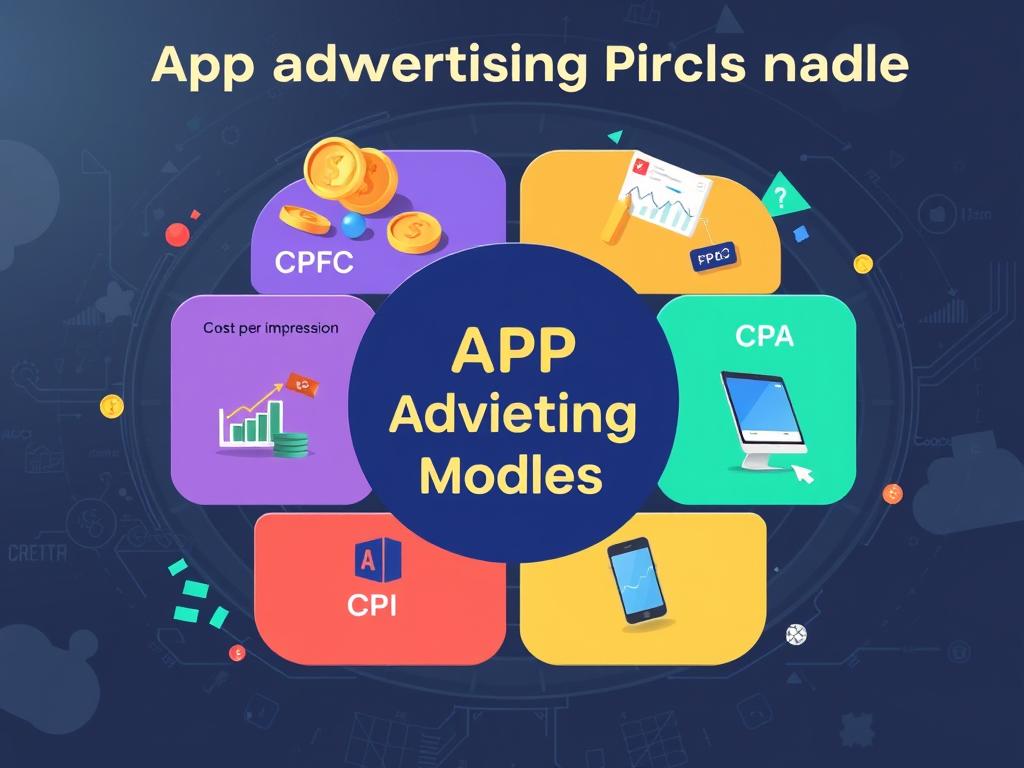The dynamic world of mobile app advertising is an intricate ecosystem where careful budget allocation can make or break your app’s visibility. With over 8.9 million apps competing for user attention on Google Play and Apple’s App Store, understanding the nuances of mobile app advertising costs is critical. From pre-launch to post-launch, the expenses cover a spectrum, including app market research, launch campaigns, and user engagement initiatives.
Average costs for app store advertising vary significantly by platform and ad model. For example, search ads have an average CPI of $1.42, Google Ads at $2.65, and social media ads across Instagram, Facebook, and TikTok range from $2.88 to $3.75 per install. Additionally, the costs for rewarded videos’ CPM average $15 on iOS and $11 on Android. Whether you’re considering CPM rates for banner ads, full-screen ads, or exploring options like CPA and CPI, each model presents its unique cost and benefit structure.
Investing in comprehensive app marketing strategies, including ASO tools priced between $25 to $1,500 per month and influencer marketing with management fees ranging from $10,000 to $18,000, can significantly enhance your mobile ad spend efficiency. With consistent analysis and strategic execution, you can navigate the extensive landscape of app store advertising expenses effectively.
Understanding the Basics of App Advertising Costs
App advertising involves various strategies, including App Store Optimization (ASO), mobile advertising, influencer marketing, onboarding, retention strategies, and analytics. Each of these app advertising components plays a significant role in determining your app marketing spend and influences budget optimization. Understanding these fundamental costs allows you to plan strategically and optimize your budget for a better return on investment (ROI) in mobile advertising.
ASO tools typically range from $25 to $1,500 per month, and professional ASO services may cost between $1,000 to $25,000 per app. The anticipated app install ad spend in North America is projected to reach $27.5 billion by the end of this year, demonstrating the high stakes of mobile advertising.

- Facebook offers affordable app marketing costs, with approximately $3.6 for iOS and $1.22 on Android to install a single app.
- The cost of optimizing user onboarding ranges from $45 to $65 per hour for an experienced UX/UI Designer and Analyst.
- Influencer marketing costs vary greatly, depending on the collaboration type and the influencer’s reach. Payment can include fixed fees or revenue percentages.
- Retention tools can cost between $100 to $2,500 per month, according to the number of users and features offered.
Budget optimization is crucial. Popular mobile app analytics tools like Firebase, Google Analytics, Mixpanel, Amplitude, and AppsFlyer (MMP) help analyze mobile app KPIs for data-driven budget allocation. This ensures that funds are directed towards the most effective marketing strategies.
App marketing budgets can range from $1,000 to tens of millions of dollars. It is recommended to spend 12-20% of gross revenue on marketing initially, decreasing to 6-12% as the app becomes more established. Setting SMART goals for your marketing campaigns is vital for long-term success. Experimenting with different strategies and focusing on the most profitable channels can lead to better budget optimization and an improved ROI in mobile advertising.
| Cost Component | Estimated Cost |
|---|---|
| ASO Tools and Services | $25 – $25,000 per month |
| App Install Ad Spend (North America) | $27.5 billion annually |
| Facebook App Install (iOS/Android) | $3.6 / $1.22 per install |
| Optimizing User Onboarding | $45 – $65 per hour |
| Influencer Marketing | Varies |
| Retention Tools | $100 – $2,500 per month |
Types of App Advertising Models
Understanding various *app ad pricing models* is crucial for optimizing your advertising efforts and achieving the best return on investment. These models differ significantly in how advertisers are charged based on user engagement and actions, aligning expenses with different stages of engagement from awareness to action.
Cost Per Mile (CPM)
CPM, or Cost Per Mile, refers to the cost of a thousand impressions of an ad. This model is ideal for brand awareness campaigns where the primary goal is to reach as many people as possible. According to recent data, average in-app CPM for mobile ads varies significantly, with banner ads bringing in as low as $0.05 to $0.91 per thousand impressions. For those looking to maximize per-impression revenue, native ads on mobile can generate up to $10 per thousand impressions.
Cost Per Click (CPC)
The CPC model is based on the number of clicks an ad receives. This strategy is focused on interactive engagement, making it suitable for campaigns aimed at driving traffic to a website or an app. As of 2016, the average global CPC for *mobile advertising payment* was around $0.27. This pricing model ensures that advertisers only pay when users actively engage with the advertisement.
Cost Per Install (CPI)
Cost Per Install is a popular choice for mobile apps, where advertisers are charged each time an app is installed via their ad. This model directly ties payment to *app user acquisition cost*, making it a highly accountable approach for marketers. Given the rise of mobile apps, projected to near a billion dollars by 2023, CPI has become an essential metric for evaluating the success of app advertising campaigns.
Cost Per Action (CPA)
Under the CPA model, advertisers pay only when a user completes a specific action, such as signing up for a service or making a purchase. This model can be particularly effective for performance-driven campaigns where the end goal is a particular user action. Using various *app ad pricing models* like CPA can provide better control over advertising budgets, as money is spent only when a positive outcome is achieved. Visit this guide on in-app advertising to delve deeper into these models and their applications.

Factors Influencing How Much Does App Advertising Cost
When it comes to app advertising, several factors can influence the overall cost, including platform variations and ad format complexity. Understanding these aspects can help you allocate your ad budget more effectively and achieve better targeting efficiency.
Platform Variations
The type of platform you choose has a significant impact on ad platform cost differences. Historically, iOS users are wealthier and thus more expensive to target. On average, brands can expect to pay 30 percent more to reach iOS users compared to Android users. Specific prices also vary by mobile ad network and exchange, with some platforms charging up to 500 percent more for ads targeting iOS users.
Additionally, the average CPM (Cost Per Mille) reflects these differences. For instance, the average CPM across all Android devices is $2, while it skyrockets to $5 for all iOS hardware. Therefore, knowing your target audience’s device type can help optimize your ad spend.
Geographical location is another critical factor. The cost per click (CPC) varies significantly across countries. For example, in Sweden, the average CPC for a mobile ad is $0.51, while it’s as low as $0.03 per click in Bulgaria. Understanding these regional differences can refine your ad targeting strategies and improve targeting efficiency.
Ad Format and Complexity
The complexity and interactivity of your ad format can significantly influence costs. Interactive mobile ads, such as video and rich-media ads, often command higher prices due to their higher engagement rates. For instance, while the average CPM for banner ads in mobile environments is $1, mobile video ads can cost 300 percent more.
- Banner Ads: Average CPM of just $1.
- Mobile Interstitial Ads: Average CPM of $3.50.
- Native Ads: Average CPM of $10.
Time of day also affects pricing. Ads run during peak hours, when user engagement is high, tend to be more expensive. Therefore, strategically scheduling your ads can ensure that you get the best return on investment.
In summary, understanding the ad platform cost differences, leveraging interactive mobile ads, and improving targeting efficiency through informed decisions can significantly impact your app advertising success.
Average Costs Across Major Platforms
Understanding the average costs of advertising on major platforms is crucial for determining your digital marketing spend. Each platform has distinct characteristics influencing its cost structures and performance metrics. Here we delve into social media advertising costs and highlight platform-specific CPI rates for popular choices like Google Ads, Facebook, Instagram, and TikTok. Knowing these rates helps you make informed decisions to optimize your marketing budget effectively.
Google Ads
Google Ads offers comprehensive reach and competitive rates. The average Cost Per Install (CPI) on Google Ads is $2.65. A Cost Per Click (CPC) of $2.32 and Cost Per Mile (CPM) of $38.40 make Google a viable option for those seeking broad visibility. When allocating your digital marketing spend, Google Ads provide a blend of cost efficiency and extensive reach.
Facebook Ads
Facebook remains a dominant force in social advertising. Its CPI stands at $3.75 for iOS and $1.22 for Android. The platform has a CPC of $1.35 and CPM of $8.60. Given these social media advertising costs, Facebook Ads are favored for targeting diverse demographic segments effectively.
Instagram Ads
Instagram, as a visually-driven platform, has a CPI of $3.50. The CPC is notably higher at $3.56, and CPM averaging $8.96. It’s essential to recognize these platform-specific CPI rates when planning campaigns, especially considering Instagram’s potential for high user engagement and brand visibility.
TikTok Ads
TikTok is rapidly emerging as a critical player in the app marketing space. The average CPI on TikTok is $2.88. Although newer, the platform is effective in reaching a younger audience, making it a compelling option for innovative and creative advertising initiatives. By understanding these costs, you can better optimize your digital marketing spend on TikTok to capture this vibrant user base.
By comparing these platforms, it’s evident how social media advertising costs and platform-specific CPI rates play a significant role in shaping your marketing strategy. Balancing your digital marketing spend across these channels enables you to maximize ROI and achieve targeted outreach efficiently.
Conclusion
Summing up app advertising expenses is essential to understand the diverse cost structures that come with various ad models and platforms. From high-performing rewarded video ads with CPMs ranging between $6.1 and $12.6 in the US and UK to more economical banner ads averaging $0.20 to $0.56, the landscape of app advertisement is multifaceted. With RPMs potentially exceeding $10 in certain scenarios, it’s clear that the right strategy can maximize returns effectively.
Maximizing app marketing budget is critical in achieving significant user acquisition and retention. Factors such as platform variations, ad format durability, and engagement levels can heavily impact overall costs. For instance, different ad impressions and session counts per user—often ranging from 1.5 to 4 sessions per month as observed with Choicely’s customers—play a crucial role in dictating the financial outlay. Additionally, balancing ad frequency with user experience ensures sustained engagement and conversion rates.
Leveraging effective cost strategies, brands can focus on optimizing their ad spend by targeting specific demographics, utilizing platform-specific analytics, and timing their campaigns strategically. For instance, the rise in iOS non-organic installs by 60% YoY and a notable iOS user acquisition expenditure increase of $6.6 billion in 2023 demonstrate the importance of platform-focused approaches. Ultimately, the goal is to enhance your app marketing budget to ensure the best possible returns on investment, supporting a robust and sustainable app growth journey.
FAQ
How much does app advertising cost?
How Does the Cost of App Advertising Affect What I Should Charge for Ads on My App?
The cost of app advertising plays a critical role in pricing advertising rates for mobile apps. To remain competitive, it’s essential to analyze market trends, ad placement performance, and user engagement. A strategic approach ensures your rates align with industry standards while maximizing revenue potential and appealing to advertisers seeking valuable exposure.
FAQ
How much does app advertising cost?
App advertising costs can vary significantly based on several factors including the platform, ad format, and targeting options. The average Search Ads Cost Per Install (CPI) is
FAQ
How much does app advertising cost?
App advertising costs can vary significantly based on several factors including the platform, ad format, and targeting options. The average Search Ads Cost Per Install (CPI) is $1.42, Google Ads CPI is $2.65, and Social Media Ads CPI ranges from $2.88 to $3.75 per install.
What are the basics of app advertising costs?
Understanding app advertising costs involves breaking down the expenses into various stages such as Pre-Launch, Launch, and Post-Launch. Factors like app market research, App Store Optimization (ASO) tools, marketing agency fees, and user engagement campaigns also contribute to the overall cost.
What are the different types of app advertising models?
The primary app advertising models are Cost Per Mile (CPM), Cost Per Click (CPC), Cost Per Install (CPI), and Cost Per Action (CPA). Each model has different pricing mechanisms and is suitable for different stages of user engagement, from awareness to action.
How does platform variation affect app advertising costs?
Platform variations significantly impact app advertising costs. iOS ads can cost up to 30% more than Android ads due to the higher target audience affluence. Additionally, targeting smartphone users might differ in cost compared to targeting tablet users.
What role does ad format and complexity play in app advertising costs?
Ad formats and their complexity greatly influence costs. Interactive video ads, for example, are more expensive due to higher engagement rates. Simple banner ads might cost less but also yield lower interaction rates.
What are the average costs of advertising across major platforms?
Average costs vary by platform. Google Ads have a CPI of $2.65. Facebook Ads for iOS have a CPI of $3.75, while Android’s CPI is $1.22. Instagram’s CPI stands at $3.50, and TikTok’s CPI is $2.88. These costs reflect platform reach, user engagement, and effectivity.
How can you optimize your app marketing budget for better ROI?
To maximize ROI, it’s essential to strategically allocate your budget by analyzing mobile app KPIs, optimizing your user acquisition funnel, and balancing spend across different ad formats and platforms. Understanding the impacts of targeting efficiencies, timing, and user engagement strategies can lead to more effective use of your app marketing budget.
.42, Google Ads CPI is .65, and Social Media Ads CPI ranges from .88 to .75 per install.
What are the basics of app advertising costs?
Understanding app advertising costs involves breaking down the expenses into various stages such as Pre-Launch, Launch, and Post-Launch. Factors like app market research, App Store Optimization (ASO) tools, marketing agency fees, and user engagement campaigns also contribute to the overall cost.
What are the different types of app advertising models?
The primary app advertising models are Cost Per Mile (CPM), Cost Per Click (CPC), Cost Per Install (CPI), and Cost Per Action (CPA). Each model has different pricing mechanisms and is suitable for different stages of user engagement, from awareness to action.
How does platform variation affect app advertising costs?
Platform variations significantly impact app advertising costs. iOS ads can cost up to 30% more than Android ads due to the higher target audience affluence. Additionally, targeting smartphone users might differ in cost compared to targeting tablet users.
What role does ad format and complexity play in app advertising costs?
Ad formats and their complexity greatly influence costs. Interactive video ads, for example, are more expensive due to higher engagement rates. Simple banner ads might cost less but also yield lower interaction rates.
What are the average costs of advertising across major platforms?
Average costs vary by platform. Google Ads have a CPI of .65. Facebook Ads for iOS have a CPI of .75, while Android’s CPI is
FAQ
How much does app advertising cost?
App advertising costs can vary significantly based on several factors including the platform, ad format, and targeting options. The average Search Ads Cost Per Install (CPI) is $1.42, Google Ads CPI is $2.65, and Social Media Ads CPI ranges from $2.88 to $3.75 per install.
What are the basics of app advertising costs?
Understanding app advertising costs involves breaking down the expenses into various stages such as Pre-Launch, Launch, and Post-Launch. Factors like app market research, App Store Optimization (ASO) tools, marketing agency fees, and user engagement campaigns also contribute to the overall cost.
What are the different types of app advertising models?
The primary app advertising models are Cost Per Mile (CPM), Cost Per Click (CPC), Cost Per Install (CPI), and Cost Per Action (CPA). Each model has different pricing mechanisms and is suitable for different stages of user engagement, from awareness to action.
How does platform variation affect app advertising costs?
Platform variations significantly impact app advertising costs. iOS ads can cost up to 30% more than Android ads due to the higher target audience affluence. Additionally, targeting smartphone users might differ in cost compared to targeting tablet users.
What role does ad format and complexity play in app advertising costs?
Ad formats and their complexity greatly influence costs. Interactive video ads, for example, are more expensive due to higher engagement rates. Simple banner ads might cost less but also yield lower interaction rates.
What are the average costs of advertising across major platforms?
Average costs vary by platform. Google Ads have a CPI of $2.65. Facebook Ads for iOS have a CPI of $3.75, while Android’s CPI is $1.22. Instagram’s CPI stands at $3.50, and TikTok’s CPI is $2.88. These costs reflect platform reach, user engagement, and effectivity.
How can you optimize your app marketing budget for better ROI?
To maximize ROI, it’s essential to strategically allocate your budget by analyzing mobile app KPIs, optimizing your user acquisition funnel, and balancing spend across different ad formats and platforms. Understanding the impacts of targeting efficiencies, timing, and user engagement strategies can lead to more effective use of your app marketing budget.
.22. Instagram’s CPI stands at .50, and TikTok’s CPI is .88. These costs reflect platform reach, user engagement, and effectivity.
How can you optimize your app marketing budget for better ROI?
To maximize ROI, it’s essential to strategically allocate your budget by analyzing mobile app KPIs, optimizing your user acquisition funnel, and balancing spend across different ad formats and platforms. Understanding the impacts of targeting efficiencies, timing, and user engagement strategies can lead to more effective use of your app marketing budget.
How Does the Cost of App Advertising Affect What I Should Charge for Ads on My App?
The cost of app advertising plays a critical role in pricing advertising rates for mobile apps. To remain competitive, it’s essential to analyze market trends, ad placement performance, and user engagement. A strategic approach ensures your rates align with industry standards while maximizing revenue potential and appealing to advertisers seeking valuable exposure.
FAQ
How much does app advertising cost?
App advertising costs can vary significantly based on several factors including the platform, ad format, and targeting options. The average Search Ads Cost Per Install (CPI) is
FAQ
How much does app advertising cost?
App advertising costs can vary significantly based on several factors including the platform, ad format, and targeting options. The average Search Ads Cost Per Install (CPI) is $1.42, Google Ads CPI is $2.65, and Social Media Ads CPI ranges from $2.88 to $3.75 per install.
What are the basics of app advertising costs?
Understanding app advertising costs involves breaking down the expenses into various stages such as Pre-Launch, Launch, and Post-Launch. Factors like app market research, App Store Optimization (ASO) tools, marketing agency fees, and user engagement campaigns also contribute to the overall cost.
What are the different types of app advertising models?
The primary app advertising models are Cost Per Mile (CPM), Cost Per Click (CPC), Cost Per Install (CPI), and Cost Per Action (CPA). Each model has different pricing mechanisms and is suitable for different stages of user engagement, from awareness to action.
How does platform variation affect app advertising costs?
Platform variations significantly impact app advertising costs. iOS ads can cost up to 30% more than Android ads due to the higher target audience affluence. Additionally, targeting smartphone users might differ in cost compared to targeting tablet users.
What role does ad format and complexity play in app advertising costs?
Ad formats and their complexity greatly influence costs. Interactive video ads, for example, are more expensive due to higher engagement rates. Simple banner ads might cost less but also yield lower interaction rates.
What are the average costs of advertising across major platforms?
Average costs vary by platform. Google Ads have a CPI of $2.65. Facebook Ads for iOS have a CPI of $3.75, while Android’s CPI is $1.22. Instagram’s CPI stands at $3.50, and TikTok’s CPI is $2.88. These costs reflect platform reach, user engagement, and effectivity.
How can you optimize your app marketing budget for better ROI?
To maximize ROI, it’s essential to strategically allocate your budget by analyzing mobile app KPIs, optimizing your user acquisition funnel, and balancing spend across different ad formats and platforms. Understanding the impacts of targeting efficiencies, timing, and user engagement strategies can lead to more effective use of your app marketing budget.
.42, Google Ads CPI is .65, and Social Media Ads CPI ranges from .88 to .75 per install.
What are the basics of app advertising costs?
Understanding app advertising costs involves breaking down the expenses into various stages such as Pre-Launch, Launch, and Post-Launch. Factors like app market research, App Store Optimization (ASO) tools, marketing agency fees, and user engagement campaigns also contribute to the overall cost.
What are the different types of app advertising models?
The primary app advertising models are Cost Per Mile (CPM), Cost Per Click (CPC), Cost Per Install (CPI), and Cost Per Action (CPA). Each model has different pricing mechanisms and is suitable for different stages of user engagement, from awareness to action.
How does platform variation affect app advertising costs?
Platform variations significantly impact app advertising costs. iOS ads can cost up to 30% more than Android ads due to the higher target audience affluence. Additionally, targeting smartphone users might differ in cost compared to targeting tablet users.
What role does ad format and complexity play in app advertising costs?
Ad formats and their complexity greatly influence costs. Interactive video ads, for example, are more expensive due to higher engagement rates. Simple banner ads might cost less but also yield lower interaction rates.
What are the average costs of advertising across major platforms?
Average costs vary by platform. Google Ads have a CPI of .65. Facebook Ads for iOS have a CPI of .75, while Android’s CPI is
FAQ
How much does app advertising cost?
App advertising costs can vary significantly based on several factors including the platform, ad format, and targeting options. The average Search Ads Cost Per Install (CPI) is $1.42, Google Ads CPI is $2.65, and Social Media Ads CPI ranges from $2.88 to $3.75 per install.
What are the basics of app advertising costs?
Understanding app advertising costs involves breaking down the expenses into various stages such as Pre-Launch, Launch, and Post-Launch. Factors like app market research, App Store Optimization (ASO) tools, marketing agency fees, and user engagement campaigns also contribute to the overall cost.
What are the different types of app advertising models?
The primary app advertising models are Cost Per Mile (CPM), Cost Per Click (CPC), Cost Per Install (CPI), and Cost Per Action (CPA). Each model has different pricing mechanisms and is suitable for different stages of user engagement, from awareness to action.
How does platform variation affect app advertising costs?
Platform variations significantly impact app advertising costs. iOS ads can cost up to 30% more than Android ads due to the higher target audience affluence. Additionally, targeting smartphone users might differ in cost compared to targeting tablet users.
What role does ad format and complexity play in app advertising costs?
Ad formats and their complexity greatly influence costs. Interactive video ads, for example, are more expensive due to higher engagement rates. Simple banner ads might cost less but also yield lower interaction rates.
What are the average costs of advertising across major platforms?
Average costs vary by platform. Google Ads have a CPI of $2.65. Facebook Ads for iOS have a CPI of $3.75, while Android’s CPI is $1.22. Instagram’s CPI stands at $3.50, and TikTok’s CPI is $2.88. These costs reflect platform reach, user engagement, and effectivity.
How can you optimize your app marketing budget for better ROI?
To maximize ROI, it’s essential to strategically allocate your budget by analyzing mobile app KPIs, optimizing your user acquisition funnel, and balancing spend across different ad formats and platforms. Understanding the impacts of targeting efficiencies, timing, and user engagement strategies can lead to more effective use of your app marketing budget.
.22. Instagram’s CPI stands at .50, and TikTok’s CPI is .88. These costs reflect platform reach, user engagement, and effectivity.
How can you optimize your app marketing budget for better ROI?
To maximize ROI, it’s essential to strategically allocate your budget by analyzing mobile app KPIs, optimizing your user acquisition funnel, and balancing spend across different ad formats and platforms. Understanding the impacts of targeting efficiencies, timing, and user engagement strategies can lead to more effective use of your app marketing budget.
What are the basics of app advertising costs?
What are the different types of app advertising models?
How does platform variation affect app advertising costs?
What role does ad format and complexity play in app advertising costs?
What are the average costs of advertising across major platforms?
How Does the Cost of App Advertising Affect What I Should Charge for Ads on My App?
The cost of app advertising plays a critical role in pricing advertising rates for mobile apps. To remain competitive, it’s essential to analyze market trends, ad placement performance, and user engagement. A strategic approach ensures your rates align with industry standards while maximizing revenue potential and appealing to advertisers seeking valuable exposure.
FAQ
How much does app advertising cost?
App advertising costs can vary significantly based on several factors including the platform, ad format, and targeting options. The average Search Ads Cost Per Install (CPI) is
FAQ
How much does app advertising cost?
App advertising costs can vary significantly based on several factors including the platform, ad format, and targeting options. The average Search Ads Cost Per Install (CPI) is $1.42, Google Ads CPI is $2.65, and Social Media Ads CPI ranges from $2.88 to $3.75 per install.
What are the basics of app advertising costs?
Understanding app advertising costs involves breaking down the expenses into various stages such as Pre-Launch, Launch, and Post-Launch. Factors like app market research, App Store Optimization (ASO) tools, marketing agency fees, and user engagement campaigns also contribute to the overall cost.
What are the different types of app advertising models?
The primary app advertising models are Cost Per Mile (CPM), Cost Per Click (CPC), Cost Per Install (CPI), and Cost Per Action (CPA). Each model has different pricing mechanisms and is suitable for different stages of user engagement, from awareness to action.
How does platform variation affect app advertising costs?
Platform variations significantly impact app advertising costs. iOS ads can cost up to 30% more than Android ads due to the higher target audience affluence. Additionally, targeting smartphone users might differ in cost compared to targeting tablet users.
What role does ad format and complexity play in app advertising costs?
Ad formats and their complexity greatly influence costs. Interactive video ads, for example, are more expensive due to higher engagement rates. Simple banner ads might cost less but also yield lower interaction rates.
What are the average costs of advertising across major platforms?
Average costs vary by platform. Google Ads have a CPI of $2.65. Facebook Ads for iOS have a CPI of $3.75, while Android’s CPI is $1.22. Instagram’s CPI stands at $3.50, and TikTok’s CPI is $2.88. These costs reflect platform reach, user engagement, and effectivity.
How can you optimize your app marketing budget for better ROI?
To maximize ROI, it’s essential to strategically allocate your budget by analyzing mobile app KPIs, optimizing your user acquisition funnel, and balancing spend across different ad formats and platforms. Understanding the impacts of targeting efficiencies, timing, and user engagement strategies can lead to more effective use of your app marketing budget.
.42, Google Ads CPI is .65, and Social Media Ads CPI ranges from .88 to .75 per install.
What are the basics of app advertising costs?
Understanding app advertising costs involves breaking down the expenses into various stages such as Pre-Launch, Launch, and Post-Launch. Factors like app market research, App Store Optimization (ASO) tools, marketing agency fees, and user engagement campaigns also contribute to the overall cost.
What are the different types of app advertising models?
The primary app advertising models are Cost Per Mile (CPM), Cost Per Click (CPC), Cost Per Install (CPI), and Cost Per Action (CPA). Each model has different pricing mechanisms and is suitable for different stages of user engagement, from awareness to action.
How does platform variation affect app advertising costs?
Platform variations significantly impact app advertising costs. iOS ads can cost up to 30% more than Android ads due to the higher target audience affluence. Additionally, targeting smartphone users might differ in cost compared to targeting tablet users.
What role does ad format and complexity play in app advertising costs?
Ad formats and their complexity greatly influence costs. Interactive video ads, for example, are more expensive due to higher engagement rates. Simple banner ads might cost less but also yield lower interaction rates.
What are the average costs of advertising across major platforms?
Average costs vary by platform. Google Ads have a CPI of .65. Facebook Ads for iOS have a CPI of .75, while Android’s CPI is
FAQ
How much does app advertising cost?
App advertising costs can vary significantly based on several factors including the platform, ad format, and targeting options. The average Search Ads Cost Per Install (CPI) is $1.42, Google Ads CPI is $2.65, and Social Media Ads CPI ranges from $2.88 to $3.75 per install.
What are the basics of app advertising costs?
Understanding app advertising costs involves breaking down the expenses into various stages such as Pre-Launch, Launch, and Post-Launch. Factors like app market research, App Store Optimization (ASO) tools, marketing agency fees, and user engagement campaigns also contribute to the overall cost.
What are the different types of app advertising models?
The primary app advertising models are Cost Per Mile (CPM), Cost Per Click (CPC), Cost Per Install (CPI), and Cost Per Action (CPA). Each model has different pricing mechanisms and is suitable for different stages of user engagement, from awareness to action.
How does platform variation affect app advertising costs?
Platform variations significantly impact app advertising costs. iOS ads can cost up to 30% more than Android ads due to the higher target audience affluence. Additionally, targeting smartphone users might differ in cost compared to targeting tablet users.
What role does ad format and complexity play in app advertising costs?
Ad formats and their complexity greatly influence costs. Interactive video ads, for example, are more expensive due to higher engagement rates. Simple banner ads might cost less but also yield lower interaction rates.
What are the average costs of advertising across major platforms?
Average costs vary by platform. Google Ads have a CPI of $2.65. Facebook Ads for iOS have a CPI of $3.75, while Android’s CPI is $1.22. Instagram’s CPI stands at $3.50, and TikTok’s CPI is $2.88. These costs reflect platform reach, user engagement, and effectivity.
How can you optimize your app marketing budget for better ROI?
To maximize ROI, it’s essential to strategically allocate your budget by analyzing mobile app KPIs, optimizing your user acquisition funnel, and balancing spend across different ad formats and platforms. Understanding the impacts of targeting efficiencies, timing, and user engagement strategies can lead to more effective use of your app marketing budget.
.22. Instagram’s CPI stands at .50, and TikTok’s CPI is .88. These costs reflect platform reach, user engagement, and effectivity.
How can you optimize your app marketing budget for better ROI?
To maximize ROI, it’s essential to strategically allocate your budget by analyzing mobile app KPIs, optimizing your user acquisition funnel, and balancing spend across different ad formats and platforms. Understanding the impacts of targeting efficiencies, timing, and user engagement strategies can lead to more effective use of your app marketing budget.
How Does the Cost of App Advertising Affect What I Should Charge for Ads on My App?
The cost of app advertising plays a critical role in pricing advertising rates for mobile apps. To remain competitive, it’s essential to analyze market trends, ad placement performance, and user engagement. A strategic approach ensures your rates align with industry standards while maximizing revenue potential and appealing to advertisers seeking valuable exposure.
FAQ
How much does app advertising cost?
App advertising costs can vary significantly based on several factors including the platform, ad format, and targeting options. The average Search Ads Cost Per Install (CPI) is
FAQ
How much does app advertising cost?
App advertising costs can vary significantly based on several factors including the platform, ad format, and targeting options. The average Search Ads Cost Per Install (CPI) is $1.42, Google Ads CPI is $2.65, and Social Media Ads CPI ranges from $2.88 to $3.75 per install.
What are the basics of app advertising costs?
Understanding app advertising costs involves breaking down the expenses into various stages such as Pre-Launch, Launch, and Post-Launch. Factors like app market research, App Store Optimization (ASO) tools, marketing agency fees, and user engagement campaigns also contribute to the overall cost.
What are the different types of app advertising models?
The primary app advertising models are Cost Per Mile (CPM), Cost Per Click (CPC), Cost Per Install (CPI), and Cost Per Action (CPA). Each model has different pricing mechanisms and is suitable for different stages of user engagement, from awareness to action.
How does platform variation affect app advertising costs?
Platform variations significantly impact app advertising costs. iOS ads can cost up to 30% more than Android ads due to the higher target audience affluence. Additionally, targeting smartphone users might differ in cost compared to targeting tablet users.
What role does ad format and complexity play in app advertising costs?
Ad formats and their complexity greatly influence costs. Interactive video ads, for example, are more expensive due to higher engagement rates. Simple banner ads might cost less but also yield lower interaction rates.
What are the average costs of advertising across major platforms?
Average costs vary by platform. Google Ads have a CPI of $2.65. Facebook Ads for iOS have a CPI of $3.75, while Android’s CPI is $1.22. Instagram’s CPI stands at $3.50, and TikTok’s CPI is $2.88. These costs reflect platform reach, user engagement, and effectivity.
How can you optimize your app marketing budget for better ROI?
To maximize ROI, it’s essential to strategically allocate your budget by analyzing mobile app KPIs, optimizing your user acquisition funnel, and balancing spend across different ad formats and platforms. Understanding the impacts of targeting efficiencies, timing, and user engagement strategies can lead to more effective use of your app marketing budget.
.42, Google Ads CPI is .65, and Social Media Ads CPI ranges from .88 to .75 per install.
What are the basics of app advertising costs?
Understanding app advertising costs involves breaking down the expenses into various stages such as Pre-Launch, Launch, and Post-Launch. Factors like app market research, App Store Optimization (ASO) tools, marketing agency fees, and user engagement campaigns also contribute to the overall cost.
What are the different types of app advertising models?
The primary app advertising models are Cost Per Mile (CPM), Cost Per Click (CPC), Cost Per Install (CPI), and Cost Per Action (CPA). Each model has different pricing mechanisms and is suitable for different stages of user engagement, from awareness to action.
How does platform variation affect app advertising costs?
Platform variations significantly impact app advertising costs. iOS ads can cost up to 30% more than Android ads due to the higher target audience affluence. Additionally, targeting smartphone users might differ in cost compared to targeting tablet users.
What role does ad format and complexity play in app advertising costs?
Ad formats and their complexity greatly influence costs. Interactive video ads, for example, are more expensive due to higher engagement rates. Simple banner ads might cost less but also yield lower interaction rates.
What are the average costs of advertising across major platforms?
Average costs vary by platform. Google Ads have a CPI of .65. Facebook Ads for iOS have a CPI of .75, while Android’s CPI is
FAQ
How much does app advertising cost?
App advertising costs can vary significantly based on several factors including the platform, ad format, and targeting options. The average Search Ads Cost Per Install (CPI) is $1.42, Google Ads CPI is $2.65, and Social Media Ads CPI ranges from $2.88 to $3.75 per install.
What are the basics of app advertising costs?
Understanding app advertising costs involves breaking down the expenses into various stages such as Pre-Launch, Launch, and Post-Launch. Factors like app market research, App Store Optimization (ASO) tools, marketing agency fees, and user engagement campaigns also contribute to the overall cost.
What are the different types of app advertising models?
The primary app advertising models are Cost Per Mile (CPM), Cost Per Click (CPC), Cost Per Install (CPI), and Cost Per Action (CPA). Each model has different pricing mechanisms and is suitable for different stages of user engagement, from awareness to action.
How does platform variation affect app advertising costs?
Platform variations significantly impact app advertising costs. iOS ads can cost up to 30% more than Android ads due to the higher target audience affluence. Additionally, targeting smartphone users might differ in cost compared to targeting tablet users.
What role does ad format and complexity play in app advertising costs?
Ad formats and their complexity greatly influence costs. Interactive video ads, for example, are more expensive due to higher engagement rates. Simple banner ads might cost less but also yield lower interaction rates.
What are the average costs of advertising across major platforms?
Average costs vary by platform. Google Ads have a CPI of $2.65. Facebook Ads for iOS have a CPI of $3.75, while Android’s CPI is $1.22. Instagram’s CPI stands at $3.50, and TikTok’s CPI is $2.88. These costs reflect platform reach, user engagement, and effectivity.
How can you optimize your app marketing budget for better ROI?
To maximize ROI, it’s essential to strategically allocate your budget by analyzing mobile app KPIs, optimizing your user acquisition funnel, and balancing spend across different ad formats and platforms. Understanding the impacts of targeting efficiencies, timing, and user engagement strategies can lead to more effective use of your app marketing budget.
.22. Instagram’s CPI stands at .50, and TikTok’s CPI is .88. These costs reflect platform reach, user engagement, and effectivity.
How can you optimize your app marketing budget for better ROI?
To maximize ROI, it’s essential to strategically allocate your budget by analyzing mobile app KPIs, optimizing your user acquisition funnel, and balancing spend across different ad formats and platforms. Understanding the impacts of targeting efficiencies, timing, and user engagement strategies can lead to more effective use of your app marketing budget.








